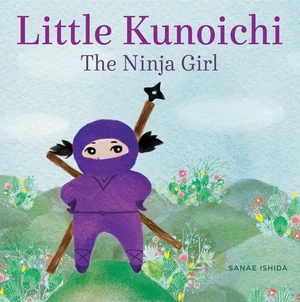A children’s book about a tiny ninja girl—do I need to say anything else? There are tiny watercolor ninjas hiding among cherry blossoms and scaling castle walls. There’s a marvelously detailed “I Spy” matsuri (festival) scene, filled with onigiri, taiko drums, sumo wrestlers, and characters from Japanese fairy tales. And there’s a family pet ninja bunny.
Overall, Seattle author and illustrator Sanae Ishida has been overwhelmed by the positive response to her book Little Kunoichi, published in April 2015 from Sasquatch Books. Inspired in part by a now-defunct Seattle store named Tiny Ninja, Little Kunoichi is a wonderful and charming book that celebrates strong Asian girls, collaboration, and the largely unsung virtue of persistence. The tiny ninja girl struggles with her lessons in ninja school: climbing, hiding, star-throwing. Then one day she finds a friend, Chibi Samurai, a friend who encourages her to shugyo, or “train like crazy,” with him for the annual Island Festival. After all, their teachers “expect to see excellence.”
Like her book’s character, Ishida is no stranger to persistence herself. It’s a value she credits in part to her Japanese immigrant parents. Her father tried many things as a serial entrepreneur, while her mother supported the family consistently with factory work for close to 20 years. Yet her mother never forgot about her own artistic side. Ishida speaks with awe about her own mother’s artistic talent. “It felt like a magic wonderland living with her,” she says. “We would mention something about fairy magic, and she would find scraps of wood and create these amazing worlds. I remember thinking anything was possible.”
Although Ishida and her two younger brothers were “groomed to be artists,” she had a difficult time claiming her artistic side. She pursued “more practical” degrees in business and education, then in communication studies, at UCLA. Yet she kept a daily journal for 30 years, and continues to do so. The daily journal work helped Ishida practice her craft, both writing and illustrating. She kept writing and drawing, pen-and-ink at first, in her journal. Then she included more watercolor—“I was terrible at first,” she laughs—a medium she appreciates for its “unpredictability.” She kept working, ultimately starting a blog (sanaeishida.com) about creating and sewing. Her blog receives visits and comments from regular followers. The pictures of her creations are minimalist yet whimsical and beautiful. Her second book, also forthcoming from Sasquatch in 2016, is a memoir about how her path turned from a corporate career into illness and ultimately towards a joyful, creative life in sewing. “The key part,” she says, “was that [when I was creating] I felt so much more like myself.”
Having a child changed Ishida’s daily patterns, as it so often does. Ishida and her young daughter began to take the bus all over Seattle on small adventures. Ishida began to draw more small illustrations and they started to read books together. Ishida noted the lack of books about strong Asian girls, and about persistence.
“When my daughter was learning to walk, or even later, learning to ice skate,” she says, “I saw her fall down, then get up again. She kept doing that over and over again. But I saw that persistence fade as she got older, in kids her age. So I wanted to write a book about that.” In today’s parenting world where social psychologist Carol Dweck emphasizes the importance of praising student efforts over “innate” talents, this book presents a perfect example of success as the reward of consistent effort and struggle.
Moreover, Little Kunoichi is kid-tested, kid-approved. My six-year old daughter read my review copy eagerly, grabbing the book off the dining table before I’d even had a chance to read it. She loved looking for Little Kunoichi and Chibi Samurai in the festival scene, which resembles her favorite Japanese Strawberry Moshi books (a favorite series of Ishida’s as well). “This is a good book, Mommy,” she told me. Her 9-year old sister and I agree; the three of us are already hoping for a Little Kunoichi series.
*This article was originally published on the International Examiner, on December 17, 2015.
© 2015 International Examiner / Tamiko Nimura






